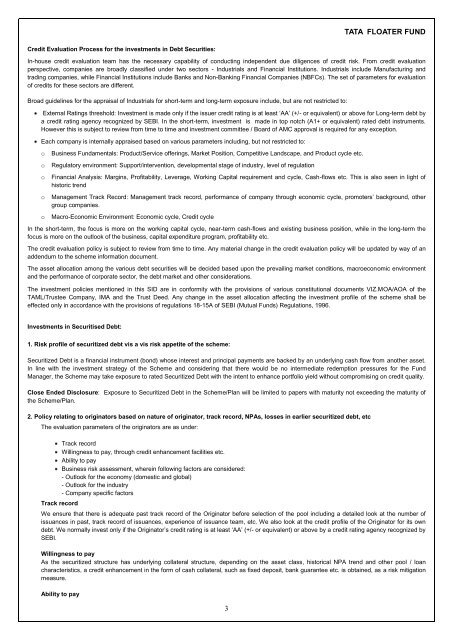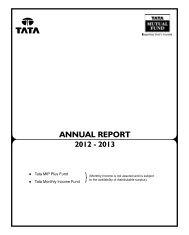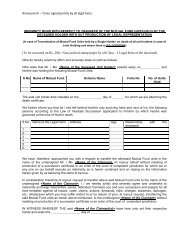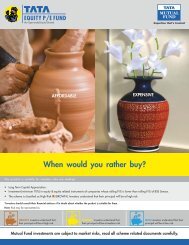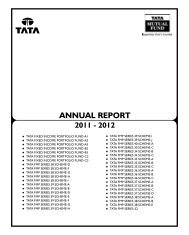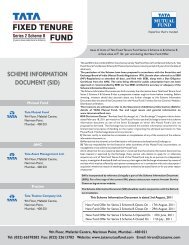Front Cover Page - Tata Mutual Fund
Front Cover Page - Tata Mutual Fund
Front Cover Page - Tata Mutual Fund
Create successful ePaper yourself
Turn your PDF publications into a flip-book with our unique Google optimized e-Paper software.
TATA FLOATER FUND<br />
Credit Evaluation Process for the investments in Debt Securities:<br />
In-house credit evaluation team has the necessary capability of conducting independent due diligences of credit risk. From credit evaluation<br />
perspective, companies are broadly classified under two sectors - Industrials and Financial Institutions. Industrials include Manufacturing and<br />
trading companies, while Financial Institutions include Banks and Non-Banking Financial Companies (NBFCs). The set of parameters for evaluation<br />
of credits for these sectors are different.<br />
Broad guidelines for the appraisal of Industrials for short-term and long-term exposure include, but are not restricted to:<br />
External Ratings threshold: Investment is made only if the issuer credit rating is at least ‘AA’ (+/- or equivalent) or above for Long-term debt by<br />
a credit rating agency recognized by SEBI. In the short-term, investment is made in top notch (A1+ or equivalent) rated debt instruments.<br />
However this is subject to review from time to time and investment committee / Board of AMC approval is required for any exception.<br />
Each company is internally appraised based on various parameters including, but not restricted to:<br />
o<br />
o<br />
o<br />
o<br />
o<br />
Business <strong>Fund</strong>amentals: Product/Service offerings, Market Position, Competitive Landscape, and Product cycle etc.<br />
Regulatory environment: Support/intervention, developmental stage of industry, level of regulation<br />
Financial Analysis: Margins, Profitability, Leverage, Working Capital requirement and cycle, Cash-flows etc. This is also seen in light of<br />
historic trend<br />
Management Track Record: Management track record, performance of company through economic cycle, promoters’ background, other<br />
group companies.<br />
Macro-Economic Environment: Economic cycle, Credit cycle<br />
In the short-term, the focus is more on the working capital cycle, near-term cash-flows and existing business position, while in the long-term the<br />
focus is more on the outlook of the business, capital expenditure program, profitability etc.<br />
The credit evaluation policy is subject to review from time to time. Any material change in the credit evaluation policy will be updated by way of an<br />
addendum to the scheme information document.<br />
The asset allocation among the various debt securities will be decided based upon the prevailing market conditions, macroeconomic environment<br />
and the performance of corporate sector, the debt market and other considerations.<br />
The investment policies mentioned in this SID are in conformity with the provisions of various constitutional documents VIZ.MOA/AOA of the<br />
TAML/Trustee Company, IMA and the Trust Deed. Any change in the asset allocation affecting the investment profile of the scheme shall be<br />
effected only in accordance with the provisions of regulations 18-15A of SEBI (<strong>Mutual</strong> <strong>Fund</strong>s) Regulations, 1996.<br />
Investments in Securitised Debt:<br />
1. Risk profile of securitized debt vis a vis risk appetite of the scheme:<br />
Securitized Debt is a financial instrument (bond) whose interest and principal payments are backed by an underlying cash flow from another asset.<br />
In line with the investment strategy of the Scheme and considering that there would be no intermediate redemption pressures for the <strong>Fund</strong><br />
Manager, the Scheme may take exposure to rated Securitized Debt with the intent to enhance portfolio yield without compromising on credit quality.<br />
Close Ended Disclosure: Exposure to Securitized Debt in the Scheme/Plan will be limited to papers with maturity not exceeding the maturity of<br />
the Scheme/Plan.<br />
2. Policy relating to originators based on nature of originator, track record, NPAs, losses in earlier securitized debt, etc<br />
The evaluation parameters of the originators are as under:<br />
Track record<br />
Track record<br />
Willingness to pay, through credit enhancement facilities etc.<br />
Ability to pay<br />
Business risk assessment, wherein following factors are considered:<br />
- Outlook for the economy (domestic and global)<br />
- Outlook for the industry<br />
- Company specific factors<br />
We ensure that there is adequate past track record of the Originator before selection of the pool including a detailed look at the number of<br />
issuances in past, track record of issuances, experience of issuance team, etc. We also look at the credit profile of the Originator for its own<br />
debt. We normally invest only if the Originator’s credit rating is at least ‘AA’ (+/- or equivalent) or above by a credit rating agency recognized by<br />
SEBI.<br />
Willingness to pay<br />
As the securitized structure has underlying collateral structure, depending on the asset class, historical NPA trend and other pool / loan<br />
characteristics, a credit enhancement in the form of cash collateral, such as fixed deposit, bank guarantee etc. is obtained, as a risk mitigation<br />
measure.<br />
Ability to pay<br />
3


